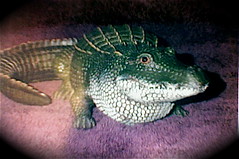Many in the top brass on Wall Street are wondering whether Secretary of Treasury Tim Geithner is the right man for putting these economic bad times behind us. Being an amateur in fiscal matters myself, I'm hardly qualified to judge, but I can say this much. After watching an hour-long interview this week with Geithner on Charlie Rose, Geithner comes off as someone with phenomenal powers of persuasion.
I've watched dozens of these Rose interviews, but not once have I ever witnessed such heights of concentrated alertness from any mere mortal. Not for a nanosecond did Geithner ever unglue his eyes from those of his interlocutor sitting across the table, nor pause to search for the precise word he needed. No momentary confusion or obfuscatory verbiage ever tainted his unassailable flawlessness at every point. In Geithner's vision, the economy is like some intricate jigsaw, in which all the disparate, ailing pieces merely await the right puzzlemaster, perhaps Geithner himself, able to reassemble the parts in one suave stroke, bringing coherency out of chaos again. Completely absorbed in his words, I had to wonder if Geithner could be right--could indeed be a one-man antibody for a rogue economy, who might actually succeed in setting things right again, if we would just follow his lead. I was certainly tempted to surrender to his expertise and suggestions of inevitable recovery. But then, a short time later, I went back to my reading of James Howard Kunstler's novel, "World Made by Hand," (which I promised to blog about in my previous post), and was immediately stopped dead in my tracks with wondering: When is happy talk like Geithner's merely cosmetic? When is it useful? When is it dubious?
The contrast between Geithner and Kunstler is nothing less than startling, like a long-running movie made by two different directors. Kunstler's mortuary novel is set in a little backwater town, Union Grove, in upstate New York (where the Battenkill River runs into the Hudson). Not only has economic recovery not taken place, but a couple of unspecified terrorist attacks have destroyed several major metropolises and vaporized the Federal Government. Ocean surges during a hurricane have left parts of Manhattan and Brooklyn uninhabitable. So what is the world, as seen through Kunstler's eyes, like after collapse?
Here, from my notes as I went along, are some key elements:
"Among us survivors were many who were confused and despondent," states the main character, Robert, who has lost his wife to encephalitis, his daughter to flu (there are no antibiotics or refrigeration), and his son, who took off at age 15 and has not been seen or heard from again. It's the end of the fossil-fuel-driven economy; there are no no laws, no infrastructure, no industry, no oil, no automobiles, no radio, no TV, phones, mail, or recreational shopping, no coffee. In this scarred remnant of our previous existence, people live by fishing, trading, and carpentry. Survivalism mixes with an unrelenting sense of loss: "It was chilling to reflect on how well the world used to work and how much we'd lost...I tried to avoid nostalgia because it could destroy you." In Kunstler's anthropology of the future, those individuals whose lives happened in the old days are the ones most devastated by this scarred world that has become a salvage operation, its scattered populations making do with lumber and sheet metal collected from derelict buildings, and getting by with the good will of helpful neighbors. In short, there has been no return to "normality."
Presumably the truth lies somewhere between Geithner's "happy talk" and Kunstler's grim vision. Then again, maybe not. It's hard to know. "I've read everything on the subprime-mortgage and banking crises I can get my hands on, writes editor Graydon Carter in the current issue of Vanity Fair, "and I still don't understand much of it." (This is the hot new club of which we are all now card-carrying members.) "As far as the global economic crisis goes," Carter states, "part of me thinks that the U.S. has gone off a cliff pretty much the way Wile E. Coyote does in the Road Runner cartoons. He doesn't drop immediately; he's suspended in midair. He knows he shouldn't be out there, but he's not plunging! Filled with hope, he begins to gingerly tiptoe his way back to the ledge. He's almost made it--he's not going to fall! And then, with a puff of dust, he's gone, plummeting far, far down into the canyon. As a nation, we might just be in the tiptoeing stage: we know we've screwed up big time, but we're praying that we can get back to the ledge before gravity takes over."
One thing is sure: there's not much room left to maneuver.
Saturday, March 14, 2009
Subscribe to:
Post Comments (Atom)

No comments:
Post a Comment